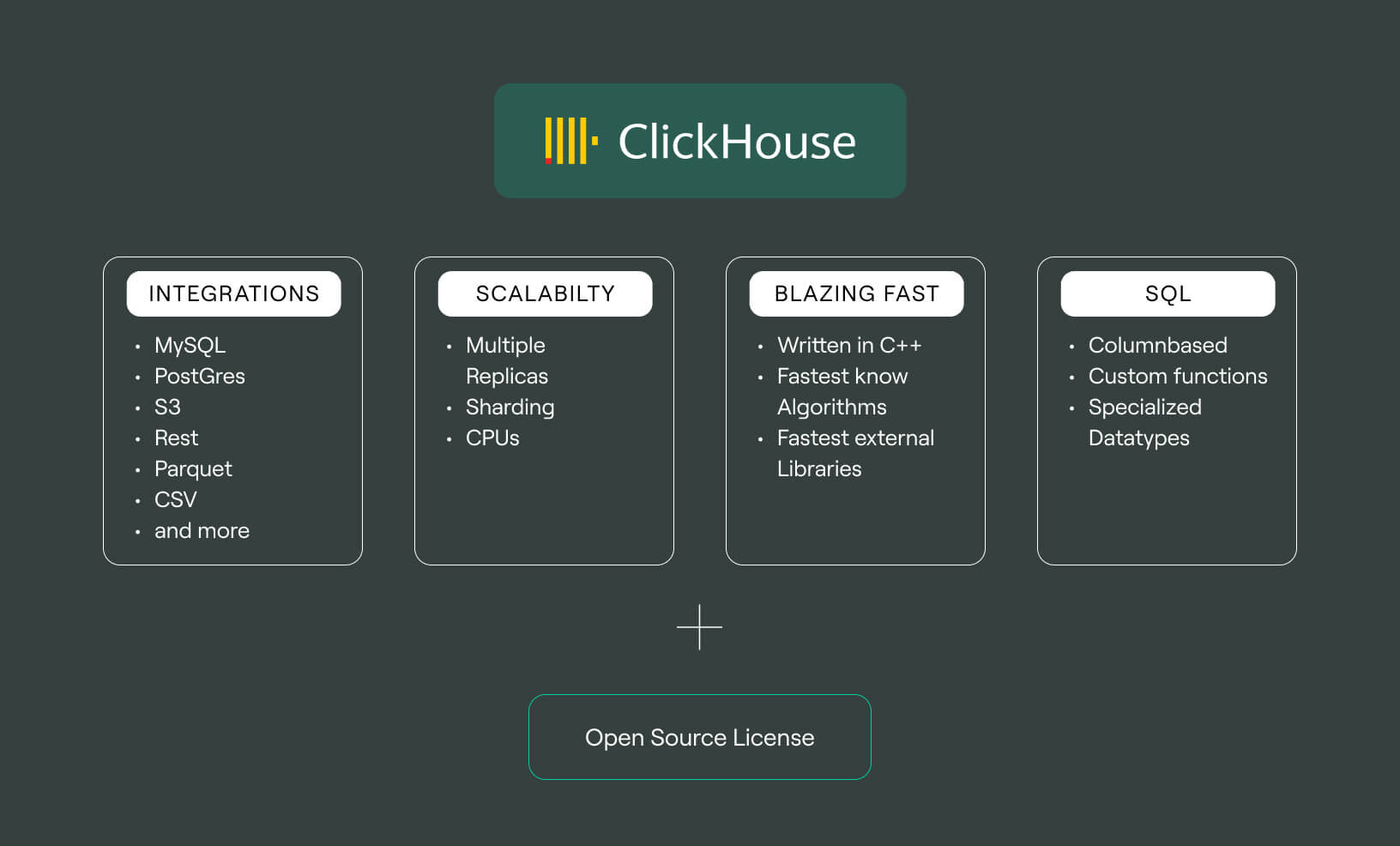
ClickHouse and Druid: A Deep Dive into Features, Use Cases, and Tradeoffs
In the constantly evolving field of data analytics, there is always a great need for efficiency and scalability in data solutions to enable businesses to take advantage of valuable insights. ClickHouse and Druid are two popular platforms with powerful features ideal for users looking to cater to real-time data and analytics workloads.
As we explore the differences between ClickHouse vs Druid, we will take a deep dive into what makes each of them unique along with their use cases. We will also explore their architectures, analytical capabilities, querying prowess, deployment, integrations, and operations.
What is ClickHouse?
ClickHouse is an online analytical processing system that allows users to analyze huge volumes of data and provides extremely high query performance capabilities. Using its distributed architecture, it processes data by dividing them into shards for onward distribution into multiple nodes.
It is a highly functional columnar storage system that is efficient and ideal for handling big data, voluminous datasets, and analytical workloads. It is close to the SQL standard, but has a lot of extensions to it, for better handling complex analytical workloads with highest performance.
ClickHouse also excels at high-concurrency scenarios and provides support for materialized views, allowing users to ingest data in bulk and efficiently precompute and store query results. For organizations looking to draw insights from the data at their disposal and tackle complex analytical and data warehousing needs, ClickHouse presents a unique solution that is suitable for batch data ingestion and OLAP use cases, as well as real-time data processing, log monitoring and IoT analytics.
What is Druid?
Druid is an open-source Apache project built to handle real-time analytics and exploration of large distributed data stored in data sets. Apache Druid is ideal for processing and storing data in use cases that require low-latency querying and analysis of high data volumes. As data volumes grow, Druid’s architecture is built with nodes that form Druid clusters, enabling the system to scale horizontally, add new nodes, and contain the data increase.
The data on Druid is usually optimized for query processing and indexing efficiency and stored in a columnar format. Just like ClickHouse, it also supports SQL-like queries with good performance that allows users to efficiently filter and aggregate data. Druid is suitable for use cases that involve real-time monitoring, IoT analytics, and user behavior analysis. Also, its strength lies in the ability to handle real-time data ingestion, low-latency queries, and exploration of high-cardinality data.
Why compare these two databases?
For users and organizations having large-scale data and extensive analytic needs with requirements for data storage, query, and real-time ingestion, it’s essential to understand the differences between ClickHouse and Druid. While both platforms have their specific areas of strength, each performs better in certain use cases than the other. For example, as aforementioned, ClickHouse provides exceptional performance in query and batch data processing in OLAP databases, but takes as much resources it can, for each single query to provide the fastest results.
Conversely, Druid’s strength lies in high concurrent query performance, handling up to 100k queries per second with an average speed for each query. Knowing these and other important differences will have users make the right decision based on their intended use case in order to maximize the data storage, processing, and analytical capabilities of the platform they choose.
Architecture
The architectural approach of ClickHouse and Druid differ in terms of data storage and query processing. While ClickHouse organizes data in the form of columns using its columnar storage model, Druid divides its data into segments to store them in a distributed manner across the cluster.
ClickHouse columnar storage method is great for data compression and faster-querying performance allowing users to efficiently run through analytical workloads. More so, ClickHouse operates on a distributed cluster of nodes when querying enabling it to handle large volumes of data with high concurrency.

On the other hand, Druid’s architecture is segmented which means data is indexed in a format that allows for rapid filtering and aggregation. This architecture is particularly ideal for streaming and high-cardinality data. Furthermore, the schema and data modeling design on ClickHouse is better suited for OLAP databases unlike the flexible schema design on Druid that supports real-time data ingestion and exploration needs.
Query capabilities
The query capabilities on ClickHouse are quite different from that of Druid in that the former supports SQL-like query language with a syntax familiar to experienced SQL database users. It provides adequate infrastructure for OLAP workloads, allowing users to filter, aggregate and process complex queries. ClickHouse also handles nested data and JSON formats efficiently, making it possible for users to analyze both structured and semi-structured data.
In contrast, Druid’s custom query language is only designed for real-time scenarios. However, it supports complex queries and aggregations and provides an efficient indexing structure. But while it does not have nested data and JSON formats, it makes up for it with mechanisms that flatten and denormalize such data. Obviously, ClickHouse’s columnar storage and query engine is a smarter choice for query performance and latency but for low-latency queries and data ingestion use cases, users may want to consider Druid.
Hardware
ClickHouse and Druid have different hardware requirements for running the platforms effectively. ClickHouse is great for analytical workloads and therefore needs high-performance CPUs with abundant memory capacity to function efficiently. Its columnar storage format also means it requires sufficient space to store and retrieve data at scale. To add to that, ClickHouse functions better when used on fast storage drives, such as SSDs that help improve its query performance.
Hardware requirement for Druid which requires a distributed system of nodes to handle high ingestion rates and large data volumes including a sufficient CPU and memory space for each Druid node. This will enable the system efficiently meet data query processing and indexing requirements. Storage systems with high I/O throughput also make it possible for Druid to provide data ingestion and deep storage of data segments.
Scalability
Scalability on ClickHouse is achieved through vertical and horizontal scaling methods. Vertical scaling can be done in different directions, depending on the identified bottlenecks. Better CPU, more cores, higher memory, faster disks etc all lead to better overall performance of clickhouse. Horizontal scaling on the other hand, comes also in two flavors: a) replication, which allows to add more nodes for scaling reads and concurrency and b) sharding, to scale high load write performance and up to petabytes of analytical queries.
Druid is built to scale out real-time querying and ingestion of data. Its distributed cluster of nodes allows for horizontal scaling of the storage system by adding nodes to the cluster. Druid also handles high ingestion rates and high query concurrency projects by apportioning data in segments for more efficiency and performance. Additionally, Druid is built to excel in real-time analytics streaming and high-cardinality data.
Performance
ClickHouse query performance is exceptional with high throughput and low latency making it the best option for OLAP workloads and complex analytical queries. Industry benchmarks have shown that columnar storage system and efficient query engine provides significantly faster query processing times when compared with other databases. With sufficient system features, it delivers high resource utilization and performance efficiency.
Druid however focuses on real-time analytics on streaming and high-cardinality data with a query performance that is optimized for interactive and exploratory queries with sub-second response times. Although Druid has shown greater system resource utilization abilities due to its indexing and segmentation approach, users will need to assess their system features and use case scenarios to ascertain the expected performance and what platform will be right for it.
Use cases
To maximize the potential of these two databases, it’s important to understand that ClickHouse use cases differ from that of Druid. While ClickHouse excels in OLAP use cases, you can choose Druid for use cases involving real-time data ingestion and interactive analytics on not well formatted data. Applications of ClickHouse are commonly found in ad-hoc querying, data warehouse buildings, and real-time analytics scenarios.
Whereas, Druid is usually used in the exploration of event-driven datasets, large-scale data analytics, and high-speed querying. For batch data ingestion and scale-out scenarios, the columnar storage and efficient processing model in ClickHouse yields excellent performance compared to Druid. Although Druid’s architecture which provides data segmentation and indexing capabilities makes it possible for users to perform low-latency queries and store time-series data efficiently.
Real-time analytics
Druid and ClickHouse both possess real-time analytics capabilities but with different approaches and features. Also, data volume, query complexity, and desired latency are factors to consider when choosing between the two databases. On ClickHouse, users can perform real-time ingestion and data processing by integrating with streaming frameworks and message queues such as Apache Kafka or RabbitMQ. This allows for easy setup and materialized views and aggregations of data to provide immediate insights. The columnar storage and efficient query processing on ClickHouse also help ensure that users get a scalable high performance when processing large volumes of data with low latency.
Druid on the hand, provides real-time data ingestion through interactive analytics on high-cardinality data. Using its segmented architecture and indexing structure it enables users to store data efficiently along with fast queries.
Batch processing and historical data
Even though the two platforms are similar, there are differences in methods for processing batch and historical data on ClickHouse and Druid. By utilizing its columnar storage and parallel query execution capabilities, ClickHouse proves to be well-suited for large-scale batch processing. It offers options for data retention policies and archiving, and supports effective data ingestion through data loaders.
Users can optimize for both query performance and storage efficiency with ClickHouse’s range of storage and compression options. Druid, in contrast, emphasizes low-latency queries on recent data while concentrating on real-time and interactive analytics. Druid’s core architecture is built for high-speed ingestion and query performance on real-time and near-real-time data, though it can also handle historical data.
Ecosystem and integrations
Druid and ClickHouse both have unique ecosystems and integrations that meet various data storage and analytics needs. Users on ClickHouse can leverage its robust ecosystem with a variety of tools and integrations for their data operations. Currently, is simple to integrate with analytics workflows thanks to its robust support for SQL clients, BI tools, and data visualization platforms. In addition to that, ClickHouse seamlessly supports pipelines for data ingestion and processing owing to its strong integration with other big data technologies like Hadoop, Spark, and Kafka.
ClickHouse also provides a solid ecosystem with thorough documentation, libraries, and tools made by its active and well-developed community. Conversely, Druid provides a unique ecosystem centered on exploration and real-time analytics. By supporting SQL-like querying, it’s only able to rely on integration with streaming frameworks like Apache Kafka and other data ingestion sources. Although Druid’s ecosystem is growing, it may not have the same breadth and maturity as that of ClickHouse.
Deployment and operations
When deployment methods and operations are the case, ClickHouse and Druid have different considerations. ClickHouse can easily run on lower system hardware specifications because it has a low system requirement but that is not the case for Druid. ClickHouse also provides an extensive range of configuration options, allowing users to tune, optimize and get better database performance.
Druid which has more complex deployment requirements often needs dedicated clusters and specialized hardware to service its distributed nature. However, it also offers a comprehensive option for fine-tuning its query performance and storage operations. Furthermore, while ClickHouse offers various monitoring and management tools, including native monitoring capabilities and integrations with third-party tools like Grafana, Druid provides a comprehensive web-based UI for cluster administration.
Security and compliance
ClickHouse and Druid both offer security features and support for compliance standards, including encryption, authentication, and access controls. ClickHouse users will benefit from the fact that it supports data encryption in both resting and transit modes, enabling them to secure their data during storage and network communications. It also provides authentication mechanisms such as user/password authentication and integration with external authentication systems like LDAP. With role-based permissions on ClickHouse, users can personalize access to the database, allowing administrators to manage data access at a granular level.
Druid also provides encryption for data at rest and in transit. It also offers controlled access permissions and authentication/authorization through integration with external systems like LDAP. However, Druid supports row-level and column-level access controls, allowing users to restrict access to specific data segments or columns.
Community and support
ClickHouse and Druid have a vibrant user community that provides support and ample resources for seamless learning and troubleshooting. Although ClickHouse has a more experienced and massive community due to its larger user base that includes an active participation of developers. Through tutorials, guides, and examples, the support system offers comprehensive documentation that enables users to maximize the platform’s capabilities. The community also actively contributes to forums, discussion boards, and chat groups, which offer prompt assistance when users need it.
The Druid community is also thriving. Even though it’s a growing community, there is active developer involvement and a dedicated user base. It offers comprehensive documentation that helps users learn and troubleshoot efficiently, including a detailed wiki, tutorials, and examples. The community also participates in chat rooms, forums, and mailing lists, fostering a cooperative setting for information exchange and problem-solving.
ClickHouse vs Druid: Comparison table
|
Difference |
ClickHouse |
Druid |
|
Architecture |
Columnar storage, distributed architecture |
Distributed, hybrid storage architecture |
|
Query capabilities |
Full SQL support, OLAP database, support for complex analytical queries |
SQL-like queries, OLAP database, time series data capabilities |
|
Hardware |
Can run on commodity hardware, suitable for both small and large clusters |
Can run on commodity hardware, scalable to large clusters |
|
Scalability |
Designed for vertical and horizontal scaling, can add nodes for increased capacity |
Horizontal scaling, can add nodes to handle larger workloads |
|
Performance |
Optimized for high-performance queries, efficient columnar storage format |
Low-latency, interactive queries, can handle large volumes of data |
|
Use cases |
OLAP analytics, data warehousing, real-time analytics, time series analysis, ad hoc querying |
Real-time analytics, event-driven applications, IoT data processing |
|
Real-time analytics |
Supports real-time data ingestion and querying, low latency |
Efficient processing of real-time streaming data |
|
Batch Processing and Historical Data |
Efficient for batch data ingestion, processing, and analysis |
Handles large-scale batch ingestion and historical data analysis |
|
Ecosystem and integrations |
Integrates with various tools and frameworks like Kafka, Spark, and Hadoop |
Integrates with SQL clients, BI tools, data visualization platforms, and other big data technologies |
|
Deployment and operations |
Configuration options for performance and reliability, monitoring and management tools |
Configuration and tuning options, monitoring and management tools available |
|
Security and compliance |
Supports encryption, authentication, and access controls, complies with security standards and regulations |
Supports encryption, authentication, and access controls, complies with security standards |
|
Community and support |
Active and growing community, comprehensive documentation, forums, and chat channels for learning and troubleshooting |
Active and supportive community, extensive documentation, forums, and chat channels available |

Yango Tech launches real-time partner analytics in one week
Use Case
ClickHouse pros and cons
Pros
1. High Performance: By effectively storing data in columns, using efficient compression methods, and optimizing query processing, ClickHouse offers exceptional query performance, making it ideal for quick analytics on large datasets.
2. Scalability: As data volumes and query loads increase, ClickHouse can scale horizontally to handle them. It easily manages petabytes of data, fitting small and large clusters, and ensuring seamless scalability as your data grows.
3. Real-time Analytics: With the help of ClickHouse’s real-time data ingestion and analysis capabilities, users are empowered to gain insights and make wise choices as events take place. This technology also supports timely and useful real-time analytics.
4. Cost-Effective: The Commodity hardware used by ClickHouse eliminates the need for pricey infrastructure. It is an affordable option for data analytics, cutting down on infrastructure costs thanks to its effective resource utilization and capacity to handle heavy workloads on reasonably priced hardware.
Cons
1. Complex Data Modeling: ClickHouse’s data modeling lacks native support for intricate structures and nested relationships, making it challenging to handle complex data arrangements.
2. Limited Update/Delete Operations: ClickHouse is primarily optimized for reading data, which limits its efficiency when it comes to frequent updates or deletions.
3. Steep Learning Curve: ClickHouse’s advanced features and configuration options require a solid understanding of distributed systems and performance tuning.
Druid pros and cons
Pros
1. Real-time analytics: Druid excels at real-time analytics, enabling users to query and visualize data with low latency, making it ideal for applications that require up-to-date insights on streaming data.
2. Scalability: Druid is designed to scale horizontally, allowing users to add more nodes as data volume grows, enabling efficient processing and analysis of large datasets with high concurrency.
3. Flexible data exploration: Druid’s flexible schema and multidimensional data model enable users to explore and drill down into data, providing rich and interactive data exploration capabilities for ad-hoc analysis.
4. Strong community and ecosystem: Druid benefits from a growing and active open-source community, offering extensive resources, documentation, and integrations with various tools and technologies, making it easier to adopt and integrate into existing data ecosystems.
Cons
1. Complex setup and configuration: Setting up and configuring Druid can be complex, requiring expertise in distributed systems and knowledge of various components.
2. High resource consumption: Druid can be resource-intensive, demanding significant CPU, memory, and storage resources, especially for large-scale deployments.
3. Lack of real-time updates: Druid is designed to focus on batch ingestion, limiting its ability to handle real-time updates and requiring additional processes for near real-time data.
4. Limited SQL support: While Druid supports SQL-like querying, it has some limitations in comparison to other traditional SQL databases.
Recommendations for choosing between ClickHouse and Druid
When choosing between ClickHouse and Druid, several factors should be considered. If your use case involves primarily batch processing and historical data analysis, ClickHouse may be a suitable choice due to its exceptional performance, scalability, and efficient storage for columnar data.
Furthermore, the DoubleCloud platform offers a seamless and user-friendly experience for working with ClickHouse. It provides a simplified interface, advanced management tools, and automated processes for easy cluster deployment, scaling, and monitoring. With DoubleCloud, you can leverage the power of ClickHouse without the complexities of infrastructure management, enabling you to focus on deriving and using insights from your data.
Final words
In conclusion, ClickHouse and Druid are both powerful tools for big data analytics, each with its own strengths and considerations. ClickHouse excels in batch processing and historical data analysis, offering exceptional performance and scalability. Druid is also designed for real-time analytics, providing low-latency querying and efficient ingestion of streaming data.
While ClickHouse has a more mature ecosystem and widespread community support, Druid offers advanced features like native support for high cardinality data and real-time materialized views. Looking ahead, the big data ecosystem is likely to see further advancements in real-time analytics, integration with AI/ML frameworks, and improved data security and privacy measures.

DoubleCloud Managed Service for ClickHouse®
An open-source, managed ClickHouse DBMS service for sub-second analytics.
Start your trial today



